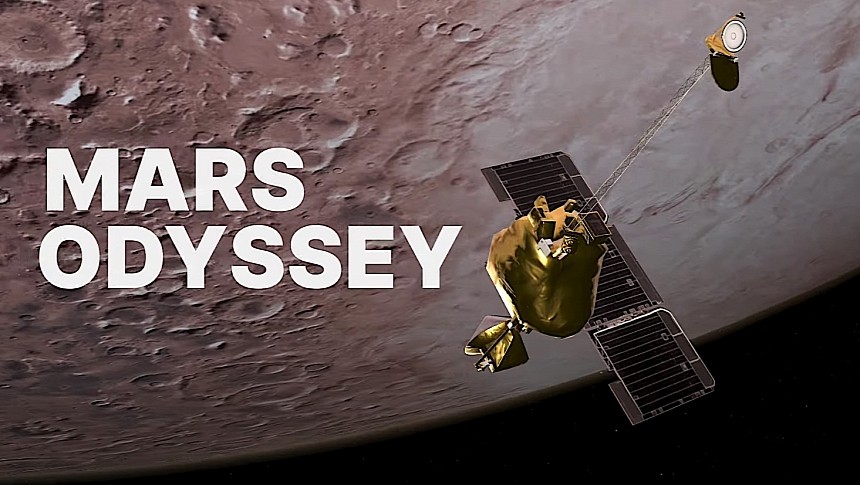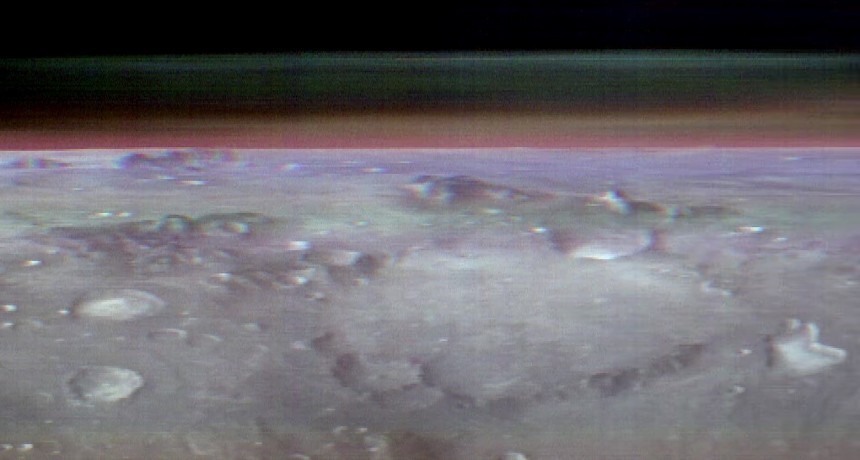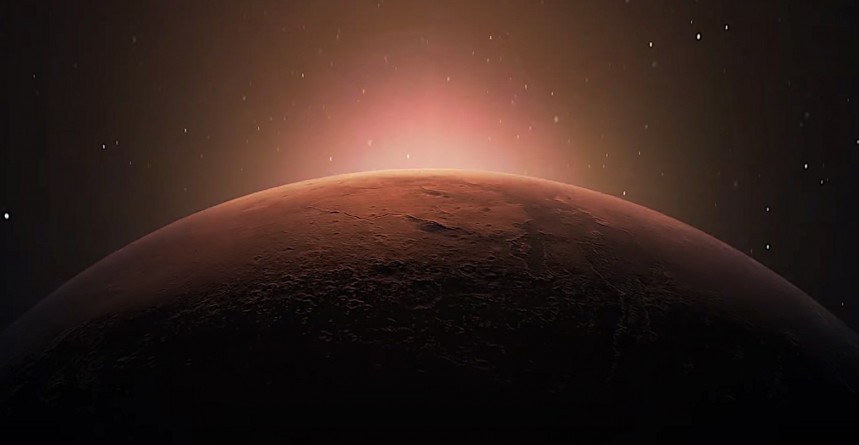Humans have looked at Mars for centuries with lust in their eyes. Over the past six decades or so, they've even reached the place, indirectly, by means of spacecraft. And yet, until now they've never seen Mars like shown in one of the photos attached to this story.
Back in April 2001, a then new piece of human-made hardware reached the orbit of Mars. It was called the Mars Odyssey Orbiter, and its main task was to look for signs of past water and ice on the surface of the planet. To accomplish its mission, it was equipped with spectrometers and a thermal imager.
Like pretty much all other pieces of technology we've sent to Mars, the robotic spacecraft had a limited lifespan: it was supposed to be in operation for just 32 months. Yet here we are now, almost 23 years into the orbiter's life, marveling at an image of its target planet the likes of which you've definitely never seen.
When I say Mars the first thing that comes to mind is probably a red or orange ball of dead rock. One with no clouds, no distinctive features (the largest canyon and largest volcano in the solar system may be seen as such, but they too tend to blend in with the surroundings), and nothing that could impress you anymore.
That image that pops into your head when hearing about Mars is probably owed to the countless stills of the place that have been released over the years. But I'm willing to bet none of them is as spectacular as this one.
First up that's because it shows a never-before-seen instance of the Red Planet's curvature. We're dealing, as per NASA, with the "first-ever views of Mars that showcase the curving horizon and layers of atmosphere."
The result of stitching a number of ten panoramic images together, the photo (below) released this week also shows layers of clouds and dust floating toward the horizon, something that we never get to see.
Add to that the two tiny moons visible in the background, and you're in for a real astronomical treat. One of them is the mighty and famous Phobos, a place of interest for Odyssey ever since its mission began: the orbiter looked at the Martian moon six times before during its mission out there, hoping to measure temperature variations across its surface.
This time, however, Phobos came into view from a different angle, and in different lighting conditions, making for a very "unique part of our Phobos dataset." These new images could lead to new discoveries about the composition and physical properties of the moon, but it might also help answer a question that's been haunting astronomers since forever: is Phobos a captured asteroid or an ancient chunk of Mars ejected during some gargantuan impact?
The ten photos that were used to put this image together were snapped from an altitude of 250 miles (400 km), giving us a view of the planet pretty much in line with how Earth is seen from the International Space Station (ISS).
It's an altitude that allowed the Odyssey to get a perspective on things no other Martian spacecraft has had before, and that could prove invaluable for humans here on Earth trying to get a better picture of the neighboring planet's atmosphere.
Like with everything related to Mars and its exploration, coming up with this photo was not an easy task. We're told people over at NASA and Lockheed Martin spent no less than three months planning the photo shoot.
They used for the task an instrument called THEMIS (Thermal Emission Imaging System), something that's capable of detecting ice, rock, sand, and dust based on their temperatures.
THEMIS usually points straight down to the surface of the planet, but for this mission its angle was adjusted. Not by moving it into a new orientation, as that's impossible because of the way it is connected to the orbiter, but by moving the entire orbiter into a new position.
More to the point, the spacecraft was rotated by 90 degrees during a carefully choreographed move that needed to keep its solar panels exposed to the light. This angle gave our scientists "a lot of detail you can't see from above," as Odyssey project scientist Jeffrey Plaut said in a statement.
This angle and perspective on the atmosphere could give humans an unprecedented view of the planet's thin covering, helping improve models on how it is structured, but most importantly of how the many layers of water-ice and dust clouds relate to one another.
Now that they've seen such a thing is possible, NASA's mission planners have a number of other such stunts in mind in the coming months. The goal is to capture similar images of the planet's horizon during all of Mars' seasons.
That only means probably even more stunning images of Mars will come our way soon, potentially revealing a lot more interesting (and potentially unknown) facts about the planet.
Like pretty much all other pieces of technology we've sent to Mars, the robotic spacecraft had a limited lifespan: it was supposed to be in operation for just 32 months. Yet here we are now, almost 23 years into the orbiter's life, marveling at an image of its target planet the likes of which you've definitely never seen.
When I say Mars the first thing that comes to mind is probably a red or orange ball of dead rock. One with no clouds, no distinctive features (the largest canyon and largest volcano in the solar system may be seen as such, but they too tend to blend in with the surroundings), and nothing that could impress you anymore.
That image that pops into your head when hearing about Mars is probably owed to the countless stills of the place that have been released over the years. But I'm willing to bet none of them is as spectacular as this one.
First up that's because it shows a never-before-seen instance of the Red Planet's curvature. We're dealing, as per NASA, with the "first-ever views of Mars that showcase the curving horizon and layers of atmosphere."
The result of stitching a number of ten panoramic images together, the photo (below) released this week also shows layers of clouds and dust floating toward the horizon, something that we never get to see.
This time, however, Phobos came into view from a different angle, and in different lighting conditions, making for a very "unique part of our Phobos dataset." These new images could lead to new discoveries about the composition and physical properties of the moon, but it might also help answer a question that's been haunting astronomers since forever: is Phobos a captured asteroid or an ancient chunk of Mars ejected during some gargantuan impact?
The ten photos that were used to put this image together were snapped from an altitude of 250 miles (400 km), giving us a view of the planet pretty much in line with how Earth is seen from the International Space Station (ISS).
It's an altitude that allowed the Odyssey to get a perspective on things no other Martian spacecraft has had before, and that could prove invaluable for humans here on Earth trying to get a better picture of the neighboring planet's atmosphere.
Like with everything related to Mars and its exploration, coming up with this photo was not an easy task. We're told people over at NASA and Lockheed Martin spent no less than three months planning the photo shoot.
They used for the task an instrument called THEMIS (Thermal Emission Imaging System), something that's capable of detecting ice, rock, sand, and dust based on their temperatures.
More to the point, the spacecraft was rotated by 90 degrees during a carefully choreographed move that needed to keep its solar panels exposed to the light. This angle gave our scientists "a lot of detail you can't see from above," as Odyssey project scientist Jeffrey Plaut said in a statement.
This angle and perspective on the atmosphere could give humans an unprecedented view of the planet's thin covering, helping improve models on how it is structured, but most importantly of how the many layers of water-ice and dust clouds relate to one another.
Now that they've seen such a thing is possible, NASA's mission planners have a number of other such stunts in mind in the coming months. The goal is to capture similar images of the planet's horizon during all of Mars' seasons.
That only means probably even more stunning images of Mars will come our way soon, potentially revealing a lot more interesting (and potentially unknown) facts about the planet.












